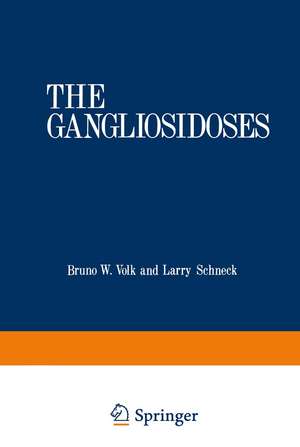The Gangliosidoses
Editat de Bruno Volken Limba Engleză Paperback – 7 feb 2012
Preț: 368.00 lei
Preț vechi: 387.38 lei
-5% Nou
Puncte Express: 552
Preț estimativ în valută:
70.41€ • 73.72$ • 58.27£
70.41€ • 73.72$ • 58.27£
Carte tipărită la comandă
Livrare economică 05-19 aprilie
Preluare comenzi: 021 569.72.76
Specificații
ISBN-13: 9781461587286
ISBN-10: 146158728X
Pagini: 296
Ilustrații: XVIII, 278 p.
Dimensiuni: 152 x 229 x 16 mm
Greutate: 0.4 kg
Ediția:Softcover reprint of the original 1st ed. 1975
Editura: Springer Us
Colecția Springer
Locul publicării:New York, NY, United States
ISBN-10: 146158728X
Pagini: 296
Ilustrații: XVIII, 278 p.
Dimensiuni: 152 x 229 x 16 mm
Greutate: 0.4 kg
Ediția:Softcover reprint of the original 1st ed. 1975
Editura: Springer Us
Colecția Springer
Locul publicării:New York, NY, United States
Public țintă
ResearchCuprins
1 Historical Review.- 2 Biochemical and Clinical Aspects.- Chemical Analysis.- Distribution and Development Patterns.- Biosynthesis and Degradation.- Biological Function.- Clinical Aspects.- Storage Compounds.- Enzyme Defects.- References.- 3 Enzymes.- Tay-Sachs Disease [GM2 (B)].- Sandhoff’s Disease [GM2 (0)].- The Relationship between Glycosphingolipid Accumulation in Tay-Sachs Disease Variants and Their Hexosaminidase Activity Patterns.- Detection of Tay-Sachs and Sandhoff’s Disease Homozygotes and Heterozygotes.- Pre- and Postnatal Detection of Tay-Sachs Disease.- Bernheimer-Seitelberger Disease [GM2 (A,B)].- GM1-Gangliosidoses.- Summary and Conclusions.- References.- 4 Pathology.- GM2-Gangliosidoses.- Bernheimer-Seitelberger Disease (AB).- GM1-Gangliosidoses.- GM3-Gangliosidosis.- References.- 5 Epidemiology.- Mode of Inheritance.- Gene and Carrier Frequencies.- Ethnologic Characteristics.- Demography of Jewish TSD Ancestors.- Evidence for Heterozygote Advantage.- References.- 6 Cell Culture Studies.- The Biology of Human Cells.- Amniocentesis and Amniotic Cell Culture.- Other Cells from Antenates and Neonates.- Enzymatic Defects.- Histochemistry and Morphology.- Gangliosides in Cultured Cells.- Culture of Neural Tissue.- The TSD Fibroblast as an Experimental Model.- Conclusion and Prospectus.- References.- 7 Spontaneous Gangliosidoses in Animals.- GM2-Gangliosidosis.- GM1-Gangliosidosis.- GM3-Gangliosidosis.- Conclusion.- References.- Appendix A Methodology: Sphingolipid Analysis.- Linda M. Hoffman, Larry Schneck.- Extraction of the Sample.- Separation of Gangliosides and Other Lipids.- Further Purification of the Ganglioside Fractions by Alkaline Methanolysis.- Thin-Layer Chromatography of Gangliosides.- Silicic Acid Column Chromatography.- FurtherPurification of the Glycolipid Fraction.- Thin-Layer Chromatography of Hexosylceramides.- Thin-Layer Chromatography of the Phospholipid Fraction Obtained from Silicic Acid Chromatography.- Further Characterization of Glycosphingolipids by Gas-Liquid Chromatography.- Methanolysis Conditions.- GLC of Fatty Acid Methyl Esters.- Preparation of Methyl Glycosides for GLC.- GLC of the Trimethylsilyl Derivatives of Methyl Glycosides.- References.- Appendix B Methodology: Enzyme Chemistry.- Guta Perle, Abraham Saifer.- Methods for the Pre- and Postnatal Detection of TSD Heterozygotes (Carriers) and Homozygotes (Patients) by Means of Hexosaminidase Analysis of Their Biological Fluids and Tissues.- Hex A Analysis of Biological Fluids with the Heat-Fractionation Method for the Detection of TSD Heterozygotes and Homozygotes.- Leukocyte, Amniotic Fluid, and Amniotic Cell Hex A Analysis by Acrylamide Gel Electrophoresis for the Detection of TSD Heterozygotes and Homozygotes.- References.- Appendix C Methodology: Histochemistry.- Masazumi Adachi, Bruno W. Volk.- Lipids.- Carbohydrates.- Proteins.- References.- Appendix D Methodology: Electron Microscopy.- Masazumi Adach, Bruno W. Volk.- Tissues.- Uncultured Cells from Amniotic Fluid.- Cultured Cells from Amniotic Fluid.- References.- Appendix E Methodology: Cell Culture.- Daniel Amsterdam, Steven E. Brooks.- Culture of Amniotic Fluid.- Primary Explant Technique.- Preservation of Cells for Long-Term Storage in Liquid Nitrogen.- Enumeration of Viable Cells.- Roller Culture for Mass Growth of Diploid Cells.- Reference.- Conclusions.











